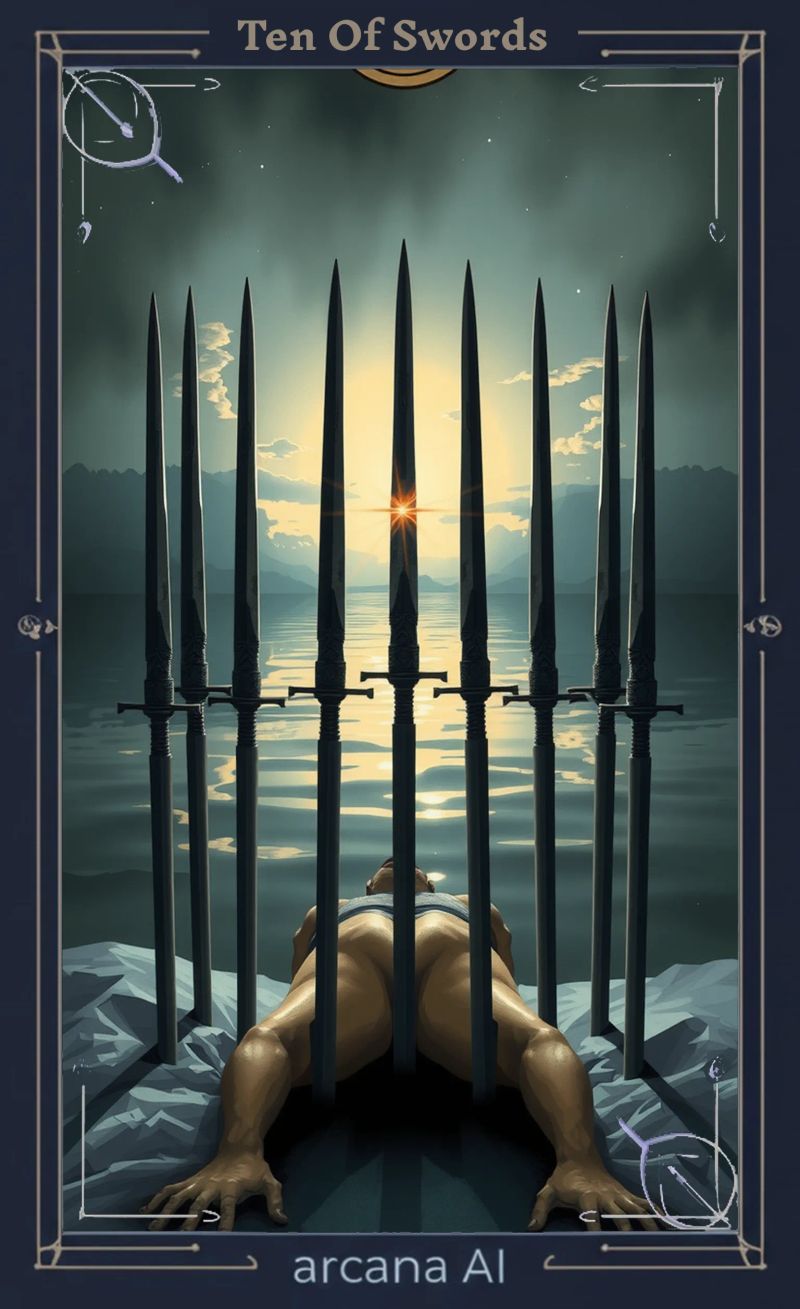Ten of Swords
Position in the Tarot Deck
Minor Arcana - Ten of Swords (59 of 78)
The Ten of Swords holds the position of the number 10 within the suit of Swords, representing the element of Air and the mental/intellectual realm. As the tenth and final card in this suit, it embodies the culmination of mental struggles, the end of a difficult cycle, and the necessary destruction that precedes renewal.
Upright Meaning
When the Ten of Swords appears upright in a reading, it signifies painful endings, betrayal, and hitting rock bottom. This card represents the darkest hour before dawn - a time when everything seems to be falling apart, often through no fault of your own. While extremely difficult, it marks the end of a challenging cycle and the potential for new beginnings.
Key Themes:
- Painful endings and difficult transitions
- Betrayal, backstabbing, or victimization
- Hitting rock bottom or crisis point
- Mental anguish and despair
- The necessary end before renewal
Practical Implications: This card often appears during major life crises, painful breakups, job losses, or situations where you’ve been deeply hurt or betrayed. The pain is very real and immediate, but the card reminds us that this represents an ending, not a permanent state. The message is that you’ve reached the lowest point, and the only way forward is up. It’s a call to release what needs to end so healing can begin.
Reversed Meaning
When reversed, the Ten of Swords indicates recovery from crisis, emerging from despair, or the beginning of healing. The intense pain represented by the upright card is starting to subside, and you’re finding the strength to pick yourself up and move forward.
Key Themes:
- Recovery from crisis or trauma
- Emerging from depression or despair
- The light at the end of the tunnel
- Rebuilding after destruction
- Hope returning after great difficulty
Practical Implications: The reversed Ten of Swords suggests that while you may still be dealing with the aftermath of a difficult situation, the worst is over. You’re beginning to see glimmers of hope and finding the inner strength to rebuild. This position indicates that healing is possible and that you’re stronger than you realize.
Symbolism and Visual Elements
In Pamela Colman Smith’s stark illustration for the Rider-Waite-Smith deck, the Ten of Swords presents a powerful image of crisis and hope:
The Fallen Figure: A person lies face down with ten swords piercing their back, representing complete defeat, betrayal, or the culmination of mental anguish. The red cloak suggests the passion or life force that has been drained by this experience.
The Ten Swords: Ten swords are arranged in a pattern across the figure’s back, symbolizing the completion of a difficult cycle and the overwhelming nature of the mental pain. The swords are firmly planted but the tips point toward the rising sun, suggesting that even in darkness, light approaches.
The Rising Sun: On the horizon, a bright yellow sun rises between two distant mountains, representing hope, renewal, and the promise that dawn follows even the darkest night. The sun’s rays extend toward the figure, suggesting that help and healing are on the way.
The Water and Mountains: Still water reflects the sunrise, symbolizing the emotional realm and the need for inner peace after turmoil. The distant mountains represent challenges that once seemed insurmountable but are now behind.
The Black Sky: The dark sky transitioning to light represents the movement from despair to hope, the end of suffering, and the beginning of healing.
Historical Context and Associations
The Ten of Swords draws from traditional tarot imagery that explores the depths of human suffering and the necessity of crisis for growth. In earlier decks, this card often depicted similar themes of defeat and ultimate transformation.
Astrological Correspondence: Associated with the Sun in Gemini, this card combines the Sun’s vitality with Gemini’s mental agility, but in challenging aspect, suggesting how mental processes can lead to complete exhaustion or breakdown.
Elemental Association: As a Swords card, it represents the Air element, governing intellect, communication, and mental processes. The number 10 suggests completion of a cycle, in this context manifesting as the necessary end of destructive mental patterns.
Card Combinations and Spread Positions
With The Tower: Amplifies themes of sudden, catastrophic change and the destruction of old structures.
With Death: Suggests the definitive end of a major life phase and the necessity of complete transformation.
With The Star: Offers hope that healing and inspiration will follow the current crisis.
In Past Position: Indicates past traumas or betrayals that still influence current behavior or fears.
In Present Position: Suggests current crisis or rock bottom that requires surrender and release.
In Future Position: Warns of potential betrayal or crisis, but also promises renewal after difficulty.
Modern Interpretations
In contemporary readings, the Ten of Swords often appears for clients dealing with:
- Painful breakups or divorce
- Job loss or career setbacks
- Betrayal by friends or colleagues
- Mental health crises or depression
- Major life transitions or losses
The key message is always about the necessity of endings for new beginnings, and the understanding that even the darkest hour precedes dawn.
Affirmation
“Though I may be experiencing great pain and difficulty, I trust that this too shall pass. I release what needs to end and open myself to the renewal that follows. I am stronger than my current circumstances.”
Explore More
Discover deeper insights about this card by using the Arcana AI app for personalized tarot readings.
